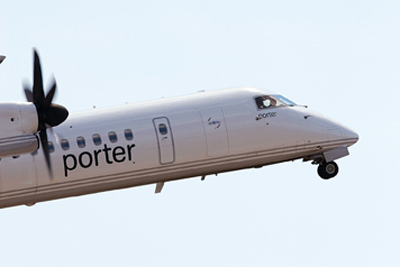
Features
Operations
At the Gate: A fortress hub at TCCA
With Porter Airlines recently celebrating its third anniversary, it might be an idea to take a closer look at its hub-and-spoke model to see if it continues to make sense.
November 24, 2009 By Brian Dunn
With Porter Airlines recently celebrating its third anniversary, it might be an idea to take a closer look at its hub-and-spoke model to see if it continues to make sense. When Porter began operations in October 2006 out of Toronto Island Airport, or Toronto City Centre Airport (TCCA), as it’s now officially called, it was a pretty straightforward business model, namely flights between TCCA and Ottawa. Then Montreal was added. Later came seasonal service between TCCA and Halifax via Ottawa, with Quebec City being added, along with year-round service to New York Newark, Thunder Bay, Chicago and Boston. The only problem is that all flights must pass through TCCA. So if somebody wants to fly from Montreal or Ottawa to Chicago, the flight stops at TCCA. Not a major inconvenience, since TCCA is geographically on the way to Chicago. But to fly from Montreal or Ottawa to Newark or Boston via Toronto? Not exactly on the way. More like out of the way. Why then, would anybody want to fly Porter from Montreal or Ottawa to Newark or Boston via Toronto instead of a direct flight on Air Canada or an American carrier?
 |
|
“Because people still prefer Porter’s service (including free beer and wine onboard) to other airlines and our proximity to downtown Toronto,” explained Porter spokesperson Brad Cicero who added the hub-and-spoke model won’t be changed anytime soon. That could be a mistake, according to several industry watchers. “Unless they offer me a real discount, which would hurt their profitability, I’m not interested in spending all that time getting there,” said Karl Moore, a management professor at McGill University. “Plus I would have to clear U.S. Customs in Toronto, because it would be a domestic flight (between Montreal and Toronto), whereas I would prefer to clear Customs in Montreal and not worry about getting to my destination late.” There are considerable savings on Porter versus other airlines if you book last minute and you’re prepared to spend four hours getting from Montreal to Newark via Toronto versus a little over an hour on Air Canada, for example.
But if you book in advance on Air Canada, the savings on Porter is only about $100 return and you’re still spending four hours travel time each way. “There’s no doubt, they’ll have to have more centres (like TCCA), because people just won’t put up with having to go through Toronto,” said one industry analyst who requested anonymity. “If I’m in Montreal, I’m not taking Porter to Boston or Newark, unless it’s the only flight available.”
The analyst suggested Porter’s hands are tied due to its small fleet, but said the airline will probably add more centres as it adds more aircraft. The hub-and-spoke model puts Porter at a real disadvantage, because flying is more about convenience than price, according to another industry analyst who spoke off the record.
“Porter can be competitive flying from point A to B, but not from A to C via B,” said the analyst. “But I think they know what’s going on and they’re realistic that there’s a certain segment of the market they won’t attract with their current model. I think they realize that people flying from Montreal to Toronto aren’t necessarily going on to Boston or Newark.”
At the same time, the analyst suggested Air Canada could get more aggressive in its pricing to maintain its share of those U.S. markets that Porter has recently entered and plans to enter. “Porter still has a good niche business, which appeals to certain travellers on their non-stop routes by offering good service, good seat pitch and downtown airport location.”
Another point of view is offered by Douglas Reid, a professor at Queen’s University School of Business specializing in the airline industry, who suggested Porter may not want to build another hub. “The problem with a second hub is that it entails a huge cost escalation and, let’s face it, Porter is a Toronto airline. And the fun part of TCCA is the lounge experience which makes people go ‘Wow’ when they see it. That would be hard to duplicate at other airports.” Reid believes Porter’s priority is to get all the slots it can at TCCA (which are limited under the tripartite agreement that controls the area) to make it a fortress hub and prevent Air Canada from moving in. “They also need to increase their load factors, which are slightly under 50 per cent by my calculations, even though they claim they’re profitable.”
Brian Dunn is a Wings writer and columnist.